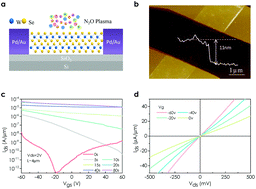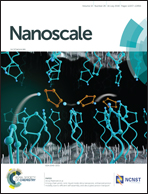Enhancing electronic and optoelectronic performances of tungsten diselenide by plasma treatment†
Abstract
Transition metal dichalcogenides (TMDCs) have recently become spotlighted as nanomaterials for future electronic and optoelectronic devices. In this work, we develop an effective approach to enhance the electronic and optoelectronic performances of WSe2-based devices by N2O plasma treatment. The hole mobility and sheet density increase by 2 and 5 orders of magnitude, reaching 110 cm2 V−1 s−1 and 2.2 × 1012 cm−2, respectively, after the treatment. At the same time, the contact resistance (Rc) between WSe2 and its metal electrode drop by 5 orders of magnitude from 1.0 GΩ μm to 28.4 kΩ μm. The WSe2 photoconductor exhibits superior performance with high responsivity (1.5 × 105 A W−1), short response time (<2 ms), high detectivity (3.6 × 1013 Jones) and very large photoconductive gain (>106). We have also built a lateral p–n junction on a single piece of WSe2 flake by selective plasma exposure. The junction reaches an exceedingly high rectifying ratio of 106, an excellent photoresponsivity of 2.49 A W−1 and a fast response of 8 ms. The enhanced optoelectronic performance is attributed to band-engineering through the N2O plasma treatment, which can potentially serve as an effective and versatile approach for device engineering and optimization in a wide range of electronic and optoelectronic devices based on 2D materials.



 Please wait while we load your content...
Please wait while we load your content...